抛轮技术–如何在轮子上制作陶器
Michelle Erickson和Robert Hunter
玛瑙陶器是一种仿造出玛瑙石和大理石纹的陶器,由各种颜色的粘土混合而成。它起源于17世纪末的英格兰,是制作许多大理石纹粘土的伟大技术之一。玛瑙陶器制作有两种类型,一种是抛轮,另一种是用手工制作的,分类为铺砌玛瑙。大理石纹陶器也指使用日文单词Neriage和Nerikomi。
在这篇文章中,Michelle Erickson和Robert Hunter解释了制陶时陶工需要考虑的重要事项,并演示了如何将制陶器扔到陶轮上。
玛瑙陶器:大理石泥的简单工艺
陶器文化背景
最早的英国投掷玛瑙是在约翰德怀特的产品中发现的(尽管他自己称之为大理石粘土)。德怀特被许多人视为英国陶器之父,因其创新而闻名于陶瓷史。他从16世纪70年代开始进行了大量的陶瓷实验,深入探讨了瓷器的奥秘,并记录了制作“大理石”陶器的配方。
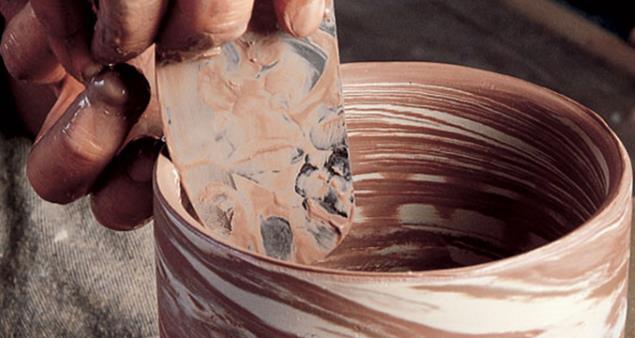
德怀特的笔记揭示了制作玛瑙的两个重要材料考虑:粘土颜色和粘土相容性。为了创造玛瑙纹路的错觉,不同颜色的粘土必须自然获得或通过修改,添加颜料或着色剂。天然粘土的色调也可以通过筛选来改变,以去除诸如铁和砂等杂质。
创造一个成功的杂色外观也取决于所用粘土颜色的比例。德怀特公式中也包含了理解与多粘土结合有关的问题的线索。这些包括收缩率、燃烧温度、密度、塑性、弹性和强度。在混合不同的粘土体时,必须考虑所有这些性质。美不该是肤浅的,探索如何用彩色粘土制作抛制陶器和手工陶器,其中美丽的表面是制作过程的一部分。Curt Bengle在他易于跟随的一步一步的视频中演示经典的彩色粘土技术,如Nerikome、Neriage和彩色防滑装饰,用彩色粘土扩展您的创作调色板。
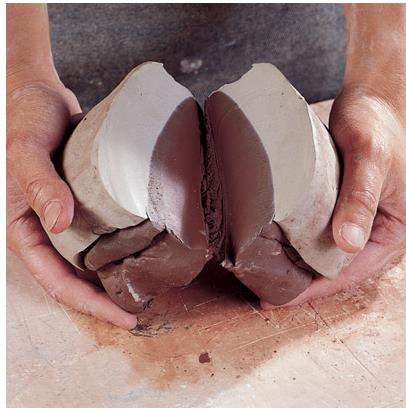
首先,建立粘土板,制作交替的颜色。然后将这一叠楔子或折叠成一个球,然后扔到轮子上。
陶器1
在楔入过程中必须小心,以确保粘土混合时不会过度扭曲或模糊形成的玛瑙图案。出于演示目的,在楔入过程中,必须在投掷前切割楔形球以显示图案,以确保粘土混合,而不会过度扭曲或模糊生成的玛瑙图案。为了演示目的,在投掷前,将楔形球切割成显示图案的形状。玛瑙图案的成功程度来自于最初的楔入过程和投掷过程。
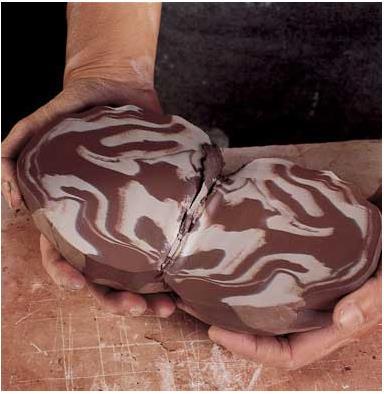
陶器2
在投掷过程中,泥体的表面会被涂抹,玛瑙图案会变得模糊。然后将准备好的粘土球集中在车轮上。一旦中心,粘土球被打开,并迅速拉入一个圆筒。在投掷过程中,泥体的表面会被涂抹,玛瑙图案会变得模糊。
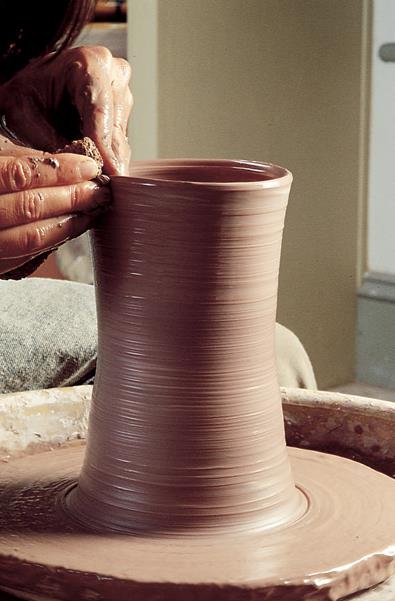
陶器3
在投掷过程中必须小心,以免使粘土过度劳累;否则,图案会变得模糊不清。这个试件被切成两半,以展示玛瑙图案是如何在粘土墙的横截面上移动的。不同的颜色应该保持不同。
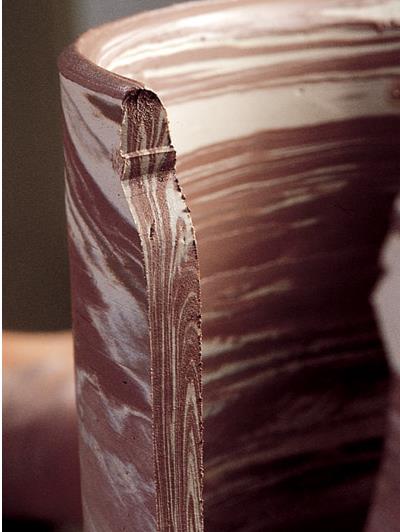
陶器4
由于斯塔福德郡几乎所有抛来的玛瑙随后都在车床上进行了修整,因此纹理通常显得尖锐而清晰。后来,在把手或喷嘴的连接点上会出现污迹和脏污,这在一些古董上可以证明。大多数陶器没有车床,但可以通过使用金属肋刮掉表面的滑动和外层粘土来显示图案。
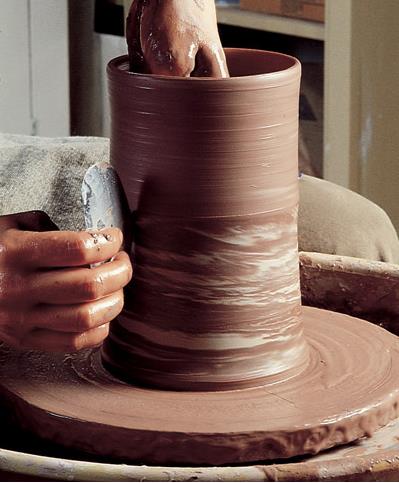
陶器5
使用一个成形的肋骨或金属肋骨再次定义了脚或基地,同时保持一个脆的格局。
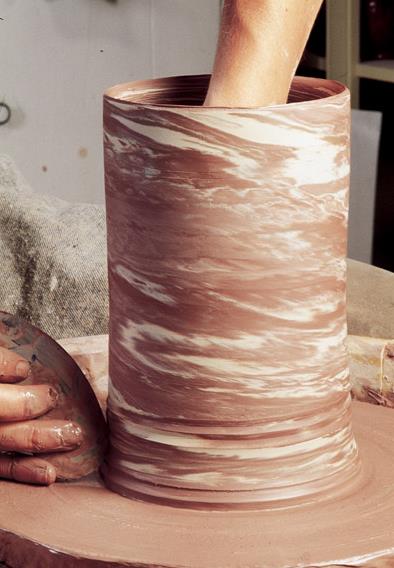
陶器6
最后,用一根金属肋刮擦模型内部,可以看到内部的玛瑙图案。
英文原文:
Wheel Throwing Techniques
How to Make Agateware Pottery on the Wheel
Michelle Erickson and Robert Hunter • October 4, 2017 •
agateware pottery opener
Agateware pottery is a type of pottery that is made from a prepared mixture of various colored clays and mimics the variegated appearance of agate stone. It originated in the late seventeenth century in England, and is one of many great techniques for marbling clay. There are two types of agateware, one is wheel thrown and the other is made using handbuilding techniques, and is classified as laid agateware. Marbling pottery is also referred to using the Japanese words neriage and nerikomi.
In this post, Michelle Erickson and Robert Hunter explain the important considerations potters need to make when making agateware pottery and demonstrate throwing agateware on the pottery wheel. – Jennifer Poellot Harnetty, editor.
Agateware Pottery: A Simple Technique for Marbling Clay
Background on Agateware Pottery
The earliest English thrown agateware is found among the products of John Dwight (even though he himself referred to it as marbled clay). Considered by many as the father of English pottery, Dwight is well known in the annals of ceramic history for his innovations. He conducted numerous ceramic experiments beginning in the 1670s, delved into the mysteries of porcelain, and recorded his recipe to produce “marbled” stoneware pottery.
Dwight’s notes reveal two important material considerations in making an agate body: clay color and clay compatibility. To create the illusion of agate striations, different color clays must be obtained naturally or by modification, adding pigments or coloring agents. The tone of a natural clay can also be altered by sieving to remove impurities such as iron and sand.
Creating a successful variegated appearance also depends on the proportions of clay colors used. Clues for understanding problems related to combining multiple clays are also contained in Dwight’s formula. These include shrinkage rates, firing temperatures, density, plasticity, elasticity, and strength. All of these properties must be considered when mixing dissimilar clay bodies.
Beauty is more than skin deep!
Discover how you can create thrown and handbuilt pottery from colored clays where beautiful surfaces are part of the process. Curt Benzle demostrates classic colored clay techniques like nerikome, neriage, and colored slip decorating in his easy-to-follow step-by-step video Expanding Your Creative Palette with Colored Clay.
Check it out and view a clip
The Agateware Pottery Process
To begin, clay slabs are built up, alternating the colors. This stack is then wedged or folded to form a ball that can then be thrown on the wheel.
agateware-pottery 1
Care has to be taken during wedging to ensure the clays are mixed without overly distorting or blurring the resultant agate pattern. For demonstration purposes, the wedged ball is cut to show the pattern prior to throwing Care has to be taken during wedging to ensure the clays are mixed without overly distorting or blurring the resultant agate pattern. For demonstration purposes, the wedged ball is cut to show the pattern prior to throwing. The degree of success in an agate pattern comes from the initial wedging process as well as the throwing.
agateware pottery 2
During throwing, the surface of the clay body becomes smeared so that agate patterning is obscured. The prepared clay ball is then centered on the wheel. Once centered, the clay ball is opened and pulled quickly into a cylinder. During throwing, the surface of the clay body becomes smeared so that agate patterning is obscured.
agateware pottery 3
Care has to be exercised during throwing so as not to overwork the clay; otherwise, the pattern becomes muddled. This test piece was cut in half to show how the agate patterning shifts in the cross section of the clay wall. The different colors should remain distinct.
agateware pottery 4
Since nearly all Staffordshire thrown agate was subsequently trimmed on the lathe, the veining usually appears sharp and crisp. Later smearing and smudging can occur at the attachment points of handles or spouts as evidenced on some antiques. Most potters don’t have a lathe, but the pattern can be revealed by using a metal rib to scrape away the slip and outer layer of clay from the surface.
agateware pottery 5
Using a shaped rib or the metal rib again defines the foot or base while maintaining a crisp pattern.
agateware pottery 6
Lastly, scraping the interior of the form with a metal rib reveals the agate pattern on the inside.
九香紫砂:九香紫砂 » 区别于紫砂壶制作的陶艺抛轮技术
紫砂交流 九香紫砂微信392503348
 紫砂壶表面的小黑点是怎么形成的
紫砂壶表面的小黑点是怎么形成的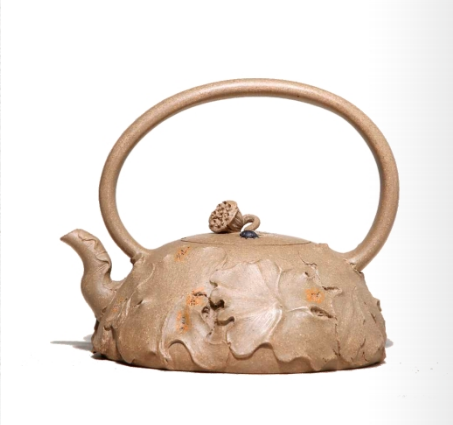
 谈谈紫砂壶的工业化与品牌化
谈谈紫砂壶的工业化与品牌化 第八届艺博杯陶艺创新作品获奖名单
第八届艺博杯陶艺创新作品获奖名单 葛明祥紫砂陶艺
葛明祥紫砂陶艺 为什么越简单地紫砂壶越难制作好
为什么越简单地紫砂壶越难制作好 如何分辨抛光紫砂壶
如何分辨抛光紫砂壶 什么是紫砂通粉
什么是紫砂通粉